Top>Opinion>Codification of the Disaster Recovery and Revitalization Law as a Means to Pursue Legal Resilience in Society
 Index
Index
Codification of the Disaster Recovery and Revitalization Law as a Means to Pursue Legal Resilience in Society
Tadashi Okamoto
Attorney-at-Law at Ginza Partners Law Office, Doctor of Laws, and Former Visiting Professor, Graduate School of Public Policy, Chuo University
Areas of Specialization:Legislation on disaster recovery and revitalization, Legislation on information management, Corporate legal affairs (internal control and business continuity), Legislation on compensation, public policy, disaster management, and risk management
The Great East Japan Earthquake as the starting point for the Disaster Recovery and Revitalization Law
In the immediate aftermath of the Great East Japan Earthquake on March 11, 2011, and the ensuing nuclear accident, lawyers in Japan were providing free legal consultation services to the people affected in order to conscientiously listen and respond to their distress. At that time, I worked at the Cabinet Office as a senior policy researcher at the Cabinet Office. With the authorization of the Cabinet Office, I individually negotiated with the Disaster Response Task Force of the Japan Federation of Bar Associations (JFBA) to be contracted as the director of the task force. The aim was to compile and analyze the legal needs in the affected areas as identified by lawyers who provided free legal consultation services that would in time be reflected in the necessary policy. In a little more than a year, a database involving over 40,000 cases was successfully compiled by JFBA alone. Shortly after the disaster, the results of the analysis of legal needs prompted many initiatives to amend or introduce new laws to support people affected by the disaster and recovery from it.
Based on the analysis of statements from numerous disaster victims and my experience in public policy at the Cabinet Office, I advocated the Disaster Recovery and Revitalization Law. For instance, I offered courses at both Keio University (2012 to present) and Chuo University (2013–2016). In addition, the idea was reflected in assistance for risk management in all kinds of sectors, including industry, academia, government, local communities, and apartment communities.
Definition of the Disaster Recovery and Revitalization Law
The missions of the Disaster Recovery and Revitalization Law are to: (1) compile the needs of disaster victims from the legal consultations, analyze their trends, and identify challenges; (2) identify problems involving existing systems and laws to propose necessary amendments and policies; and (3) keep track of the process for creating a new system in anticipation of future disasters and pass on the policy methods to future generations. The intent is to ensure that the necessary tasks continue to be carried out in the future. The law also aims to (4) facilitate education for disaster management regarding the legal system for rebuilding livelihoods. The significance of the law depends on its tangible social benefits both for people and companies.
Visualizing the legal needs of disaster victims
Direct input from disaster victims and their otherwise invisible legal needs must be visualized in order to serve as grounds for implementing policies. These grounds are called legislative facts. The detailed results from the analysis of legal needs involving the Great East Japan Earthquake are presented in the reference materials—namely, The System of the Disaster Recovery and Revitalization Law and An Encouragement of the Disaster Recovery and Revitalization Law. This article presents the trends in legal needs in the prefectures of Iwate, Miyagi, and Fukushima seen in the 40,000 consultations compiled over a period of slightly more than one year.
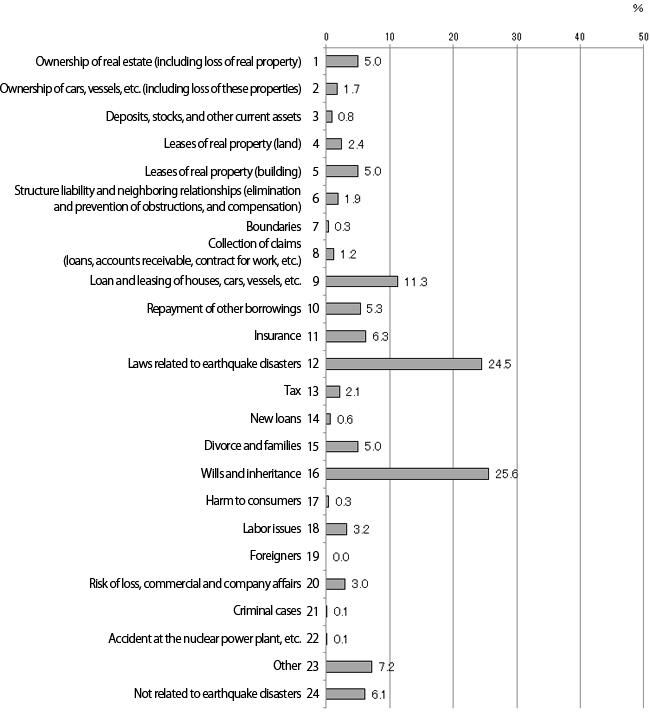
Note: The denominator for each kind of legal consultation is N = 4,925.
Figure 1: The trend in free legal consultation services provided to disaster victims in Iwate Prefecture (March 2011–May 2012)
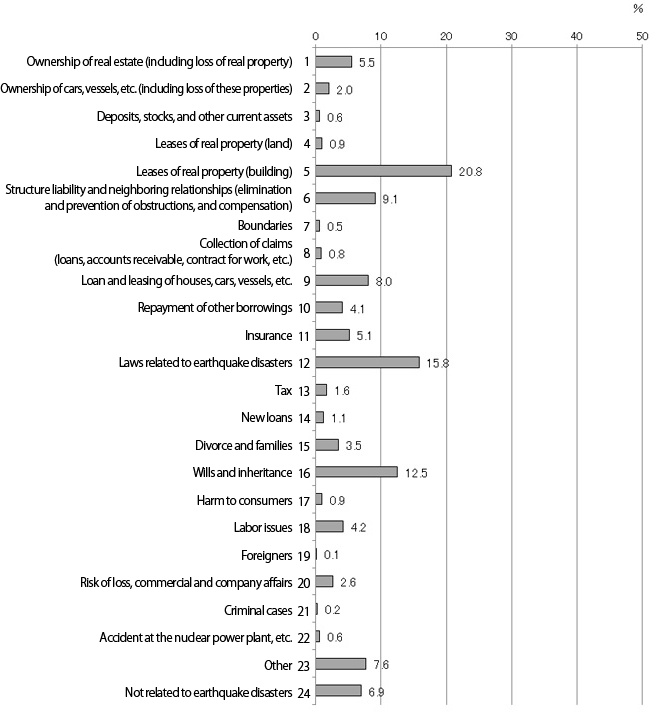
Note: The denominator for each kind of legal consultation is N = 17,736.
Figure 2: The trend in free legal consultation services provided to disaster victims in Miyagi Prefecture (March 2011–May 2012)
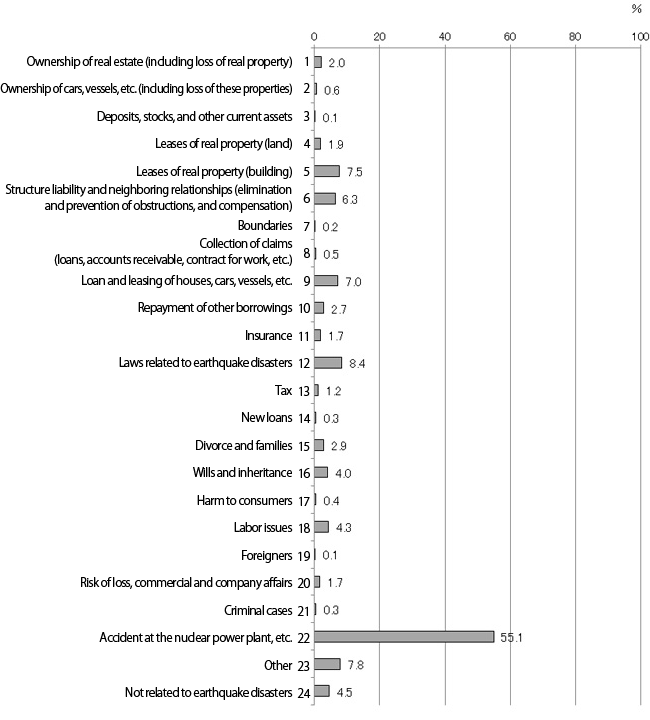
Note: The denominator for each kind of legal consultation is N = 12,294.
Figure 3: The trend in free legal consultation services provided to disaster victims in Fukushima Prefecture (March 2011–May 2012)
In the areas severely affected by the tsunami, bereaved families consulted on all kinds of inheritance issues (16: Inheritance). Many disaster victims mentioned difficulty making mortgage payments after losing their houses, jobs, and assets (9: Loan of houses). Notably, lawyers were found to play a constant and major role in compiling and providing necessary information for supporting disaster victims, which is something that should be done by the municipal governments (12: Laws related to earthquake disasters). It was also made clear that urban areas severely affected by the earthquake and tsunami and also coastal areas with devastated cities were constantly plagued by disputes over “5: Leases of real property (building).” In areas severely affected by the accident at the nuclear power plant, the overwhelming number of consultation cases involved victims’ disputes and concerns over the reconstruction efforts complicated by the accident (22: Accident at the nuclear power plant, etc.).
Contribution to the reconstruction policy and passing on necessary tasks
In the immediate aftermath of the disaster, lawyers began to make numerous proposals and helped shape the necessary policies based on the analysis of the legal needs conducted, not only classifying them by prefecture, but by municipality, chronological order, and according to attributes of disaster victims. The table below presents their contribution to the systemic revision. One example is the newly introduced Guidelines for Voluntary Liquidation by Individual Debtors as a system for reducing or exempting disaster victims from loans while avoiding the disadvantages of bankruptcy. The guidelines are applicable only to the Great East Japan Earthquake, but further discussions led to the development of Guidelines for Debt Adjustment after Natural Disasters which can be applied to all kinds of natural disasters envisaged by the Disaster Relief Act. However, many challenges remain. The improvement of the legal system for disaster recovery is still only half way to being able to deal with enormous disasters in the future. It seems it is our responsibility to codify and organize the Disaster Recovery and Revitalization Law and pass on the remaining tasks to the next generation.
- Establishment of the loan reduction and exemption system for affected individuals and entities
- The advocacy for a system for purchasing, reducing, or exempting liabilities of the affected to resolve the issue of double loans resulted in the Guidelines for Voluntary Liquidation by Individual Debtors for reducing and exempting loans of affected individuals, as well as the Act on Corporation for Revitalizing Earthquake affected Business as a system to help business turnaround by purchasing liabilities of enterprises. The call for the familiarization of the system for reducing and exempting loans for the affected prompted the Financial Services Agency to demand that financial institutions inform disaster victims of the availability of such assistance.
- Extension of deliberation period for relinquishing the right to inheritance
- The extension of the deliberation period to one year was advocated for relinquishing the right to inheritance as the three-month period according to the provision of the Civil Code was considered too short. As a result, the deliberation period was extended to November 30, 2011 pursuant to the lawmaker-initiated legislation called the “Law for a Special Rule of the Civil Code Regarding the Period for Approving or Relinquishing Inheritance associated with the Great East Japan Earthquake.” The number of applications for relinquishing inheritance or extending the deliberation period increased significantly in affected areas.
- Affected siblings included as recipients of condolence money and donations
- Earlier, affected siblings were not included as recipients of condolence money. The newly introduced Partial Amendments to the Law on Condolence Money for Disaster Victims extended the scope to include siblings who share their habitat or livelihood. Some affected municipalities amended their ordinances as a solution. Likewise, siblings used to be excluded from recipients of donations, however, prefectural governments extended the scope to include siblings.
- Prohibition of seizure of condolence money from disaster victims for their liabilities
- Formally, condolence money for disaster victims could be seized by creditors. The advocacy against the rule led to the lawmaker-initiated legislature prohibiting such seizure.
- Act Concerning Support for Reconstructing Livelihoods of Disaster Victims
- Affected households can receive up to 3 million yen under the framework to support their livelihoods. The advocacy for significantly increasing the ratio of national government subsidies to 50 percent resulted in the enactment of the act for preferential measures to increase the ratio to 80 percent.
- Inapplicability of the Act on Temporary Treatment of Rental Land and Building in Affected Cities
- The reality of consultations involving lease contracts suggested that the establishment of priority leaseholds based on the abovementioned act would hamper proper community development. After many meetings with the Ministry of Justice and Ministry of Internal Affairs and Communication that were considering the application of the act, a decision was made not to apply the act to the Great East Japan Earthquake.
- Nuclear Accident Child Victims’ Support Law
- The compilation of various needs associated with the nuclear accident proved conducive to the enactment of the Act on Promotion of Support Measures for the Lives of Disaster Victims to Protect and Support Children and Other Residents Suffering Damage due to Tokyo Electric Power Company’s Nuclear Accident. Lawyers now have the new task of proposing specific measures based on this act for supporting victims.
- 2013 amendment of the Disaster Countermeasure Basic Act
- Currently, failure of municipalities to share disaster victims’ personal information with supporters complicates the rescue and assistance for persons requiring special assistance or evacuees who must move out of their home prefectures in the event of disasters. Accordingly, JFBA submitted relevant opinions and developed guidelines for sharing personal information. The promotional symposium on proper handling of personal information in response to disasters was organized in the form of a country-wide caravan. The resulting major amendment had great impact on municipal policy on personal information. Examples include the introduction of systems for keeping a list of persons requiring evacuation assistance, safety confirmation data, and a list of disaster victims.
- Extension of extinctive prescription for the right to demand compensation for nuclear damage
- This special law is remarkable in that it covers almost a million potential targets. The Act on Measures for Ensuring Swift and Proper Compensation for Nuclear Damage Caused by the Accident at Nuclear Power Plant Triggered by the Great East Japan Earthquake and Special Rules on Extinctive Prescription for the Right to Demand Compensation, etc. extended the term of extinctive prescription for the right to demand compensation for damages in tort from three years to 10 years. The period of exclusion was changed from “20 years from the time of the tortious act” to “20 years from the time of the occurrence of the damages.”
- Deregulation for facilitating land condemnation for reconstruction
- On May 1, 2014, the Act for the Partial Amendment of the Act on Special Zones for Reconstruction in Response to the Great East Japan Earthquake was enforced. This act permits loosening of requirements for determination proceedings on land condemnation and collective relocation for disaster response to address the urgent need for swift acquisition of land needed for reconstruction efforts by providing a breakthrough in the hampered acquisition of land in affected areas whose owners are unknown, inheritance was not conducted properly, or that is shared by many owners.
Table: Examples of policies and legislations for disaster recovery advocated by lawyers
Contribution to disaster-management education and disaster management by companies
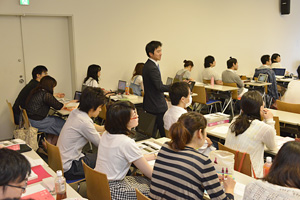
Photo 1: A course on Disaster Recovery and Revitalization Law offered at the Graduate School of Law, Keio University
The clarification of the legal needs of disaster victims gradually led to more precise understanding of the (1) trouble they experience and (2) knowledge that should be collected for preparing a legal framework for restoring the livelihoods of disaster victims and corporate recovery as a means to prevent disaster and mitigate its impact. I developed a training program for individual preparedness against disasters and reconstruction of their livelihoods based on the codification and research of the Disaster Recovery and Revitalization Law. The program is conducted in all kinds of sectors in industry, academia, and governments. For instance, many disaster victims voice their concern that they lost habitats and jobs, but they are at a loss as to where to begin. The best way to give them hope is to let them know that there is a system to publicly recognize the housing damage on a victim’s certificate. To do so, it is essential to conduct disaster-management education to gain necessary knowledge beforehand. The training program should be regarded not only as education for helping individuals restore their livelihoods, but also for restoring personnel who underpin organizations, companies, and their partner entities. That is to say, training programs for employees to gain the knowledge they need to restore their livelihoods translate into the resilience of their organization as a whole. It can be considered an integral part of business continuity planning(BCP) for establishing systems for crisis management and internal control of companies.
Striving to gain legal resilience
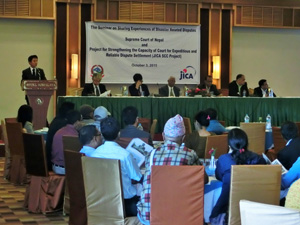
Photo 2: Seminar in response to the major earthquake that hit Nepal in April 2015 (October 2015)
The improvement of legal systems to respond to disasters is necessary precisely because we can only do as much as we have prepared for. Swift assistance to disaster victims through various policies for disaster recovery cannot be expected without laws that serve as specific guidelines for the necessary activities, as well as specific operations carried out by governments on-site. Naturally, legal systems need to constantly overcome identified challenges in keeping with the changing times and the nature of new disasters. This constant effort cultivates the legal resilience of our society. Coincidentally, resilience is an important theme of the Sustainable Development Goals (SDGs) as the UN agenda for 2030. All the more, Japan needs to communicate to the world the result of the analysis of legal needs among the vast number of disaster victims by disaster, as well as the disaster recovery policy taken by the country in response.
References
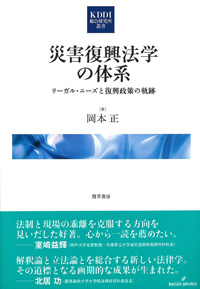
Tadashi Okamoto, System of the Disaster Recovery and Revitalization Law: Tracing Legal Needs and Recovery Policy, Keiso Shobo, 2018
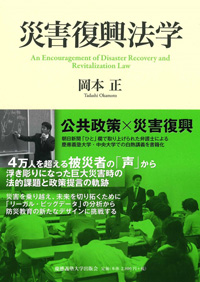
Tadashi Okamoto, An Encouragement to the Disaster Recovery and Revitalization Law, Keio University Press, 2014
- Tadashi OKAMOTO Analysis of Free Legal Counselling for the Great East Japan Earthquake and the Outlook for the Field of Disaster Recovery and Revitalization Law
 Japan Medical Association Journal (JMAJ) Vol. 59 No. 2&3 pp77-90
Japan Medical Association Journal (JMAJ) Vol. 59 No. 2&3 pp77-90 - Yomiuri Shimbun, “Face: Tadashi Okamoto—A lawyer teaching the Disaster Recovery and Revitalization Law,” Morning Edition, March 11, 2016
- NHK, “Seven Years from the Great East Japan Earthquake (2): The Disaster Recovery and Revitalization Law that responds to the voices of disaster victims,”
 Shiten Ronten, March 8, 2018
Shiten Ronten, March 8, 2018 - JICA, “Seminar for sharing experience with disputes involving earthquake disasters—Applying Japan’s experience in responding to earthquake disasters for the reconstruction of Nepal,”
 October 3, 2015
October 3, 2015
- Tadashi Okamoto
Attorney-at-Law at Ginza Partners Law Office, Doctor of Laws, and Former Visiting Professor, Graduate School of Public Policy, Chuo University
Areas of Specialization:Legislation on disaster recovery and revitalization, Legislation on information management, Corporate legal affairs (internal control and business continuity), Legislation on compensation, public policy, disaster management, and risk management -
Tadashi Okamoto was born in 1979 in Kanagawa. In 2001, he graduated from the Keio University Faculty of Law, Department of Law before earning the degree of Doctor of Laws from Niigata University in September 2017. Currently an attorney-at-law (registered in 2003 at Tokyo Bar Association I), he is a partner of the Ginza Partners Law Office. From 2009 to 2011, he served as a senior policy researcher at the Secretariat of the Government Revitalization Unit, Cabinet Office. From 2011 to 2017, he was a chief researcher of the MEXT’s Alternative Dispute Resolution Center for resolving disputes involving compensation for nuclear damage. In academic year 2012, he established a course on the Disaster Recovery and Revitalization Law and has been serving as a lecturer both at the Graduate School of Law and Faculty of Law of Keio University. From academic years 2013 to 2016, he was also a visiting professor of the Faculty of Policy Studies, Graduate School of Chuo University to conduct a course on the Disaster Recovery and Revitalization Law. His major publications include An Encouragement to the Disaster Recovery and Revitalization Law (Keio University Press, 2014) and System of the Disaster Recovery and Revitalization Law: Tracing Legal Needs and Recovery Policy (Keiso Shobo, 2018). He has frequently been featured in the media, such as NHK (Shiten Ronten), Yomiuri Shimbun (Face), and Asahi Shimbun (People).
- Research Activities as a Member of Research Fellowship for Young Scientists (DC1), Japan Society for the Promotion of Science (JSPS) Shuma Tsurumi
- Important Factors for Innovation in Payment Services Nobuhiko Sugiura
- Beyond the Concepts of Fellow Citizens and Foreigners— To Achieve SDGs Goal 10 “Reduce Inequality Within and Among Countries” Rika Lee
- Diary of Struggles in Cambodia Fumie Fukuoka
- How Can We Measure Learning Ability?
—Analysis of a Competency Self-Assessment Questionnaire— Yu Saito / Yoko Neha - The Making of the Movie Kirakira Megane









